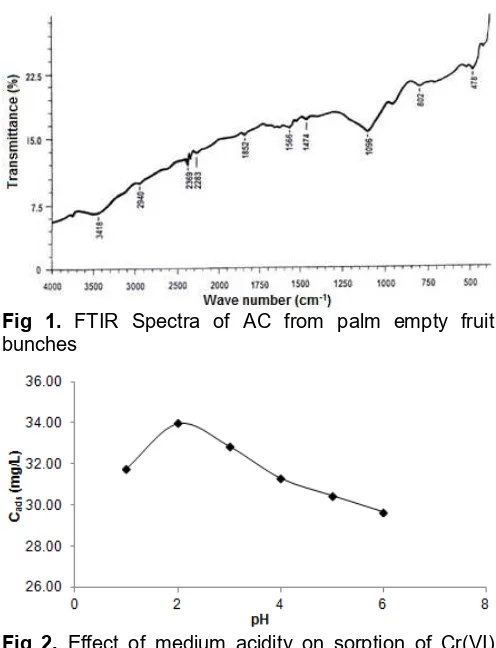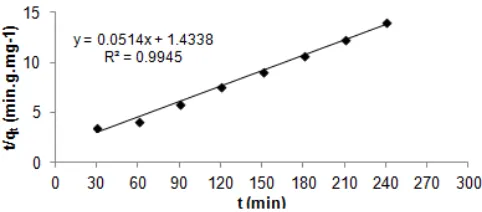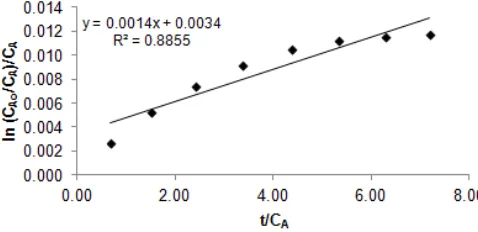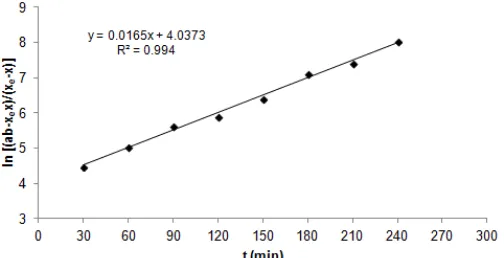REVERSIBLE SECOND ORDER KINETICS OF SORPTION-DESORPTION OF Cr(VI) ION
ON ACTIVATED CARBON FROM PALM EMPTY FRUIT BUNCHES
Iip Izul Falah
*, Ruliatima, and Triyono
Department of Chemistry, Faculty of Mathematics and Natural Sciences, Universitas Gadjah Mada Sekip Utara PO BOX BLS 21 Yogyakarta 55281, Indonesia
Received May 29, 2015; Accepted August 6, 2015
ABSTRACT
Activated carbon (AC) from palm empty fruit bunches has been prepared, and this material was then used to adsorb Cr(VI) from a solution. Characterization of the AC was conducted by detection of its functional groups, determination of total volatile compounds (VC) content and its iodine number. Study on sorption-desorption kinetics was conducted by comparing results of evaluations of several models with proposed reversible second order model using the data produced in this work. Results of the works showed that the AC had similar characters compared with the AC produced by previous researchers. Application of the kinetics models on sorption Cr(VI) onto the AC showed that nearly all of the models gave a good linearity. However, only the proposed model had a good relation with Langmuir isotherm, with respectively sorption (ks) and desorption (kd) constants were 5.75 x 10
-4
L.mg-1.min-1and 2.20 x 10-3 min-1; maximum sorption capacity, qm = 20.00 mg.g
-1
; and equilibrium constant, K from kinetics experiment (0.261 L.mg-1) was comparable with the result from the isotherm experiment (0.269 L.mg-1). Hence, using this model, kinetics and Langmuir parameters can probably be determined from a single kinetics data experiment.
Keywords:sorption-desorption; kinetics; Langmuir isotherm; reversible second order
ABSTRAK
Telah dibuat karbon aktif (AC) dari tandan kosong buah sawit, selanjutnya bahan ini digunakan untuk mengadsorb Cr(VI) dari larutan. Karakterisasi AC dilakukan dengan mendeteksi gugus-gugus fungsional, penentuan kandungan senyawa-senyawa volatil total (VC) dan bilangan iodinnya. Studi kinetika sorpsi-desorpsi dilakukan dengan membandingkan hasil evaluasi dari beberapa model dengan model orde dua reversibel yang diusulkan, menggunakan data yang dihasilkan dalam pekerjaan ini. Hasil pekerjaan ini menunjukkan bahwa AC yang dihasilkan mempunyai sifat-sifat yang sama dengan AC yang dihasilkan peneliti terdahulu. Penggunaan model kinetika sorpsi Cr(VI) pada AC menunjukkan bahwa hampir semua model menghasilkan linearitas yang baik, namun demikian, hanya model yang diusulkan yang mempunyai hubungan baik dengan isoterm Langmuir, dengan konstanta-konstanta sorpsi (ks) dan desorpsi (kd) berturut-turut 5,75 x 10
-4
L.mg-1.menit-1 dan 2,20 x 10-3 menit-1; maksimum kapasitas sorpsi, qm = 20,00 mg.g
-1
; dan konstanta keseimbangan, K dari percobaan kinetika (0,261 L.mg-1) mirip dengan hasil dari percobaan isotherm (0,269 L.mg-1). Sehingga dengan menggunakan model ini, parameter-parameter kinetika dan Langmuir dimungkinkan dapat ditentukan dari data eksperimen tunggal.
Kata Kunci:sorpsi-desorpsi; kinetika; isoterm Langmuir; orde dua reversibel
INTRODUCTION
Pollution of Cr(VI) ion could be serious problem due to this ion is toxic, carcinogenic and mutagenic in nature [1], hence, it must be removed from wastewater before discharging it into environment. The ion is usually exist in the form of CrO42 ̶ in alkaline or in the form of Cr2O72 ̶ in acidic environments which will give a new problem of large volume of toxic sludge when it is precipitated using conventional method [2], whereas the efficient methods of ion exchange, reverse osmosis and electro-dialysis are relatively expensive, therefore
sorption method becomes promising alternative available [3].
isotherm model based on a reversible process. Langmuir isotherm model seems to be more establish for monolayer sorption compare to the kinetics theory. Hema and Arivoli [9] have used a reversible process concept for the sorption dyes onto activated carbon, but their theory only consider adsorbate as a variable which can be adsorbed onto or desorbed from the adsorbent. Santosa et al. [10] have tried to develop a complex equation by considering sorption, desorption, concentration of adsorbate in solution, and fraction of unoccupied and occupied active sites on adsorbent. However, simplification of concentration of adsorbate in the solution during sorption process as a constant (CA0) seems to be questionable. Based on those problems, this paper presents a reversible sorption-desorption of adsorbate onto adsorbent by considering concentration of adsorbate in solution, unoccupied and occupied active sites on adsorbent, with the reason that most of the energy of sorption seems to be likely physisorption [7-8,10,13-15]. This paper also presents relation between sorption-desorption kinetics theory with Langmuir isotherm model at once, hence, the data of maximum sorption capacity, equilibrium constant, and sorption rate constants, can probably be evaluated from a single experiment data.
Activated carbon (AC) has been used in many studies to remove pollutants [2,4-6,8-9,13-14,16-19]. Compare with inorganic materials such as zeolite and bentonite, the utilization of AC has more advantage due to easier treatment after used of the carbon, especially when the pollutants are nonvolatile metal ions. For that reason, the sorption of Cr(VI) ion from a solution by the AC of palm empty fruit bunches is used to show performance of the sorption-desorption theory proposed in this paper. In addition, Indonesia has the widest palm plantation in the world, recently.
EXPERIMENTAL SECTION
Materials
Carbonized palm empty fruit bunches from PTPN XIII Sei Plantation, Sanggau, West Kalimantan, Indonesia. K2Cr2O7, H2SO4, HCl, iodine, and Whatman No. 42 filter paper with the label of Merck, from local market. Distilled water from physical chemistry laboratory.
Instrumentation
These works used Vulcan A-130 electric furnace, Soxhlet, Shimadzu FTIR Prestige 2, Hanna Instruments pH 211, magnetic stirrer, UV-visible spectrophotometer (Shimadzu UV-1700), closed crucible porcelain and glass ware.
Procedure
Preparation and characterization of AC
Preparation of AC followed Falah and Triyono method [20] with small modification. Carbonized palm empty fruit bunches (from PTPN XIII Sei Plantation, Sanggau, West Kalimantan, Indonesia) was activated in a closed crucible porcelain at 800 °C (using Vulcan A-130 electric furnace) for 2 h, followed by extraction using acetone in a Soxhlet apparatus, and then it was soaked into 1.0 M HCl solution for 24 h, washed by distilled water until neutral, and finally it was dried at 110 °C.
Characterization of the activated carbon was conducted by (a) detection of functional groups on the AC using Shimadzu FTIR Prestige 2 in the wave number range of 4000-450 cm-1; (b) determination of VC content by calculation the difference of weight after calcinations in a closed crucible porcelain at 800 °C and 950 °C for 10 min; (c) determination iodine number by procedure of Devi et al. [2] where the iodine number was calculated by equation (1).
difference concentration of iodine in mg Iodine number =
weight of AC in g (1)
Equilibrium study
Equilibrium study was aimed to know optimum pH, maximum sorption capacity, and equilibrium constant. This study was done by soaking 0.050 g of AC (90-170 mesh) into 25.0 mL K2Cr2O7 solution containing 50.0 mg/L of Cr(VI). After stirring for 5 h, it was filtered using Whatman No. 42 filter paper, and then concentration of Cr(VI) in filtrate was determined as described by Devi et al. [2] at wavelength of 540 nm using visible spectrophotometer (Shimadzu UV-1700). These works were done for pH of the initial solution of 1-6 (by adding H2SO4 solution and measured by Hanna Instruments pH 211), and at pH = 2, concentration of Cr(VI) in initial solution was varied at 20, 30, 40, and 50 mg/L. For these works, weight of Cr(VI) adsorbed per gram of AC after equilibrium reached, qe, were calculated using equation (2).
Co= initial Cr(VI) concentration in mg/L Ct= Cr(VI) concentration at time t in mg/L mo= mass of AC in g
V = volume of Cr(VI) solution in mL
Kinetics study
25.0 mL K2Cr2O7solution containing 50.0 mg/L of Cr(VI) at initial pH = 2. After stirred for 30 min, it was filtered using Whatman No. 42 filter paper, and then content of Cr(VI) in filtrate was determined as described by Devi et al. [2] at wavelength of 540 nm using UV-visible spectrophotometer (Shimadzu UV-1700). The work was repeated for contact time of 60, 90, 120, 150, 180, 210, 240, 270, and 300 min, respectively.
RESULT AND DISCUSSION
Characterization of AC
Fig. 1 shows FTIR spectra of AC from palm empty fruit bunches. This AC has the similar groups with AC from the other sources as showed by AC from lignin [19], coconut shell [21], and longan seed [22]. Wide band at around 3418 cm-1 is assigned to O-H stretching mode, very weak peak at 2940 cm-1 indicated the presence of methylene group, peaks at 2369-2284 cm-1 showed
stretching of C≡C. The presence of stretching of C=O
indicated by weak peak at 1851 cm-1, C=C bond indicated by peaks at 1566 cm-1and 1473 cm-1, whereas C-O bond at 1096 cm-1and 802 cm-1, and aromatic C-H at 478 cm-1. These all groups have an important role in sorption-desorption process.
Iodine number of the AC prepared in this study was 449 mg/g. This value was little higher than iodine number of charcoal and AC from longan seed treated by H3PO4 before activation (PCLGAC) [22], and it was somewhat lower compared to AC from coconut shell [2]. According to Mopoung and Nogklai [22], big adsorption capacity of AC to iodine showed the AC has big surface area, and contains abundance micro- and meso-pores. VC of the AC prepared in this study was 12%. Compare to 20% VC in AC from coconut shell produced by Devi et al. [2], this value is lower, however, compare to 3% VC in the AC produced from longan seed [22], this value is much higher. All of the difference of VC content was believed due to the different of activation time, and it was thought if these VC possibly have a contribution on adsorption capacity. Based on the properties have been discussed, it could be concluded that the AC prepared in this study had comparable quality with the AC produced by previous researchers.
Equilibrium Study
The chromium ion in aqueous solution will exist in the form of HCrO4 ̶, CrO42 ̶, or Cr2O72 ̶, depend on pH of the solution. On the other side, at high concentration of H+ (low pH), this ion can neutralize the negatively charged adsorbent surface [13], and will interact with lonely pair electrons. Therefore, pH of solution is important factor that controls the sorption of Cr(VI) onto
Fig 1. FTIR Spectra of AC from palm empty fruit bunches
Fig 2. Effect of medium acidity on sorption of Cr(VI) onto AC
the solid adsorbent. In agreement with result of Wanees et al. [17], this study showed the optimum pH of sorption of Cr(VI) onto the AC was at pH = 2 (Fig. 2). At lower pH, Cr(VI) was probably converted into Cr3+ [17]. Hence, it was repelled by positively charged of adsorbent surface (which had adsorbed H+).
Monolayer isotherm Langmuir model has been used by a lot of researchers [4-5,7-9,13-14,17,19,23-24]. This model based on sorption-desorption an adsorbate (A) onto an adsorbent (S) which can be presented by equation (3). In the case of this study, A is Cr(VI) and S is active sites on activated carbon, whereas A-S is the active sites have been occupied by adsorbate.
s d
k
k
A S A S (3)
If at equilibrium, θe is the fraction of active site
occupied by adsorbate, θo is the fraction of unoccupied
active site, θe + θo =1, and Ce is adsorbate
concentration in the solution (mg/L), then equilibrium constant can be expressed by equation (4).
1-
e
e e
K
C
(4)
Fig 3.Langmuir isotherm sorption of Cr(VI) onto AC
Fig 4. Sorption of Cr(VI) onto AC at various contact time
Fig 5. Evaluation of kinetics data of Sorption of Cr(VI) onto AC by using Lagergren pseudo-first order model
Fig 6.Evaluation of kinetics data of Sorption of Cr(VI) onto AC by using Ho and McKay pseudo-second order model
adsorbate adsorbed at equilibrium (mg/g), then qe = qm
θe, and as presented by El-Latif et al. [7], Langmuir isotherm equation (5) can readily be found.
1
e e
e m m
C C
q q Kq (5)
Result of investigation of this work showed that in the range of Cr(VI) concentrations used in this study, it had resulted monolayer adsorption as shown by Fig. 4. This conclusion was supported by result of Langmuir isotherm study, which produced linear relation between Ce/qe versus Ce (Fig. 3) with very high correlation coefficient (R2= 0.999). From the intercept and slope, it has been calculated that maximum sorption capacity, qm = 20.00 mg.g
-1
, and equilibrium constant, K = 0.269 L.mg-1.
Kinetics Study
Kinetics study on sorption and sorption-desorption has been studied by many researchers [4-11,13-18,23]. As it can be calculated from equilibrium constant (K = 0.269 L.mg-1), bond energy between Cr(VI) with active sites on activated carbon, was relatively low (< 40 kJ/mol), hence, sorption of Cr(VI) onto activated carbon was in the range of physisorption. This result was in agreement with other studies [4,9,13-14,18,23]. Therefore, general equation of kinetics models must be
based on sorption-desorption process as shown by equation (3). When bond energy is in the range of chemisorptions, rate of desorption (rd) will be very small, and can be neglected.
Individual rate of sorption (rs), desorption (rd), and the accumulation sorption rate (rA) of adsorbate, A, on the adsorbent, S, have been illustrated by Santosa et al. [10].
1
A
a s d s A o d A s A A d A
d
r r r k C k k C k
dt
(6)
where CA and θA are concentration of adsorbate and fraction of active site occupied by adsorbate at sorption time t, respectively.
As the earliest known adsorption rate, Lagergren equation is based on the adsorption capacity at equilibrium (qe) [11]. In this kinetics model, concentration of adsorbate (A) is assumed gives no effect to the adsorption rate, and rdis neglected. Hence, if qt is the active site occupied by adsorbate (A-S) at sorption time t, the rate only depend on qe – qt. From equation (3), Lagergren pseudo-first order rate can be expressed by equation (7). Integration of this equation with boundary t = 0 to t = t resulted equation (8). Evaluation of the data resulted in this study (Fig. 4) using equation (8) is shown in Fig. 5.
s e t
dq
k q q
Fig 7. Evaluation of kinetics data of Sorption of Cr(VI) onto AC by using Santosa et al. reversible pseudo-first order model
Fig 8.Evaluation of kinetics data of Sorption of Cr(VI) onto AC by using Pandey et al. reversible pseudo-first order model
ln qeqt k ts lnqe (8)
There are 3 components in equation (3), however, pseudo-second order rate of Ho and McKay only consider unoccupied active sites (qe – qt) as a variable, and rdis neglected [11-12]. The rate of this order may be written in equation (9). Result of integration of this rate equation with boundary t = 0 to t = t is presented as equation (10), and application of this model toward the data of this study is shown in Fg. 6.
2Differ from previous model, Santosa et al. [10] assumed concentration of adsorbate was constant as its initial condition (CAo), hence, this reversible pseudo-first order sorption-desorption process only depend on unoccupied and occupied active sites. Equation of accumulation reversible sorption-desorption rate and its integration result were written in equations (11) and (12), respectively [10], and yield of evaluation of this model toward the data of this study is presented in Fig. 7.
1
Pandey et al. [2010] developed reversible pseudo-first order rate equation (13) from equation (3), based on adsorbate concentration (CA) and occupied active sites on adsorbent (CAS) as variables, where the maximum occupied active sites (at equilibrium) was CAe. Integration of this rate equation gave equation (14), and result of evaluation of the data from this study by Pandey et al. model is presented in Fig. 8.
A
Result of the evaluations of the data from this study by 4 kinetics models which have been discussed showed that using Santosa et al. model, the correlation coefficient was poor (R2= 0.885). This is probably due to the weakness of assumption of adsorbate as a constant. Using both of two former models, the correlation coefficients were much better (R2 = 0.994), however, when energy of sorption is considered as physisorption due to low K value, one (forward) direction kinetics model is not logic, therefore these models has no relation with Langmuir isotherm where the process and K are shown in equation (3) and equation (4), respectively. The last evaluation using Pandey et al. model resulted the same high correlation coefficients (R2) compared with the two former models, however, calculation of K = ks/kd from the data of Pandey et al. [23] is very different compared with the K from his isotherm experiment. Hence, based on all these problems, the authors proposed a reversible second order model.
The proposed reversible second order has the same mechanism model compared with Langmuir isotherm as presented in equation (3). This kinetics model based on consideration that the successfulness of sorption depend on concentration of adsorbate in the solution, unoccupied and occupied active sites on the adsorbent, and there is no constant assumption for all of these variables. This model can be illustrated as follows.
Equation (6) can simply be written as:
A
This equation (6a) cannot be integrated due to θA,
Fig 9. Evaluation of kinetics data of Sorption of Cr(VI) onto AC by using proposed reversible second order model
simply expressed in equation (16) in which all of variables have the same unit (mg/L).
A
unoccupied active sites on the AC
CSA (= kθA) is concentration of Cr(VI) related to occupied
active sites on the AC
If at initial time, CA= a; CS0= b; and CSA= 0; and at sorption time t, CA= a-x; CS0= b-x; and CSA= x, where x is concentration of Cr(VI) has been adsorbed by adsorbent at time t, then the last equation may be written in equation (17). When it is chosen m/V = 1 g/L, then numeric value of b = qm. It means that value of maximum sorption capacity, qm, and equilibrium constant K (= kd/ks) can be evaluated from kinetics data. Therefore this reversible second order kinetics and Langmuir isotherm models are related now.
Equation (17) can be solved as follows:
(18) can readily be found, and if it is inserted into equation (17), and then being integrated with boundary x = 0 at t = 0 to x = x at t = t, involving method of partial fraction, equation (19) will be resulted.
Evaluation of kinetics data of this study (Fig. 4) by equation (19) using b = qmfrom isotherm experiment, is shown in Fig. 9. Result of this evaluation showed that the line had the same correlation coefficient compared to the result of evaluations using Lagergren, Ho and
McKay, and Pandey models (R2 = 0.994). From slope of the line in Fig. 9, it can be determined that ks= 5.75 x 10
-4
L.mg-1.min-1, and using equation (18), kd= 2.20 x 10
-3
min-1was obtained. From these kinetics constants, it can be resulted K = ks/kd = 0.261 L.mg
-1 . This K value is comparable with the value resulted from Langmuir isotherm experiment (K = 0.269 L.mg-1). Hence, this study has successfully inserted Langmuir isotherm model into proposed reversible second order model, and kinetics and Langmuir parameters can probably be determined from a single kinetics data experiment.
CONCLUSION
The AC produced in this study has similar functional groups compared with the AC produced by previous researchers, optimum sorption of the AC to Cr(VI) was at pH = 2, and its iodine number was 449 mg.g-1. Application of proposed reversible second order kinetics model toward the data of sorption-desorption Cr(VI) onto the AC gave sorption (ks) and desorption (kd) constants 5.75 x 10
-4
L.mg-1.min-1 and 2.20 x 10-3min-1, respectively. Whereas from Langmuir isotherm experiment it was produced qm= 20.00 mg.g
-1 , and K = 0.269 L.mg-1. This equilibrium constant was comparable with K = 0.261 L.mg-1 (= ks/kd) processed from kinetics data. Hence, using this proposed reversible second order model, kinetics and Langmuir parameters will have the same results, and can probably be determined from a single kinetics data experiment.
ACKNOWLEDGEMENT
Authors thank to the Indonesian government for financial support to this work under the contract number LPPM-UGM/2270/SETR/2013.
REFERENCES
1. Das, A.P., and Mishra, S., 2008, J. Environ. Res. Dev., 2 (3), 386–392.
2. Devi, B.V., Jahadirgar, A.A., and Ahmed, M.N.Z., 2012,Int. J. Eng. Res. Appl., 2 (5), 364–370. 3. Atkinson, B.W., Bux, F., and Kasan, H.C., 1998,
Water SA, 24 (2), 129–135.
4. Bhadusha, N., and Ananthabaskaran, T., 2012, E-J. Chem., 9 (1), 137–144.
5. Isichei, T.O., and Okieimen, F.E., 2012,J. Environ. Chem. Ecotoxicol., 4 (13), 234–241.
7. El-Latif, M.M.A., Ibrahim, A.M., and El-Kady, M.F., 2010,J. Am. Sci., 6 (6), 267–283.
8. Zawani, Z., Chuah, A.L., and Chong, T.S.Y., 2009, Eur. J. Sci. Res., 37, 63–71.
9. Hema, M., and Arivoli, S., 2007,Int. J. Phys. Sci., 2 (1), 10–17.
10. Santosa, S.J., Siswanta, D., Kurniawan, A., and Rahmanto, W.H., 2007, Surf. Sci., 601(22), 5155– 5161.
11. Ho, Y.S., 2006,J. Hazard. Mater., B136, 681–689. 12. Ho, Y.S., and McKay, G., 1999, Process Biochem.,
34 (5), 451–465.
13. Gholipour, M., Hashemipour, H., and Mollashahi, M., 2011,ARPN J. Eng. Appl. Sci., 6, 10–18.
14. Namasivayam, C., and Kavitha, D., 2002, Dyes Pigm., 54 (1), 47–58.
15. Namasivayam, C., and Ranganathan, K., 1994, 1994,Indian J. Chem. Technol., 1 (6), 351–355.
16. Sugumaran, P., Susan, V.P., Ravichandran, P., and Seshadri, S., 2012, J. Sustainable Energy Environ., 3, 125–132.
17. Wanees, S.A., Ahmed, A.M.M., Adam, M.S., and Mohamed, M.A., 2012,Chem. J., 02 (03) 95–105. 18. Alam, Md.Z., Muyibi, S.A., Mansor, M.F., and
Wahid, R., 2007,J. Environ. Sci., 19 (1), 103–108. 19. Sun, Y., Zhang, J.P., Yang, G., and Li, Z.H., 2006,
Chem. Biochem. Eng. Q., 20 (4), 429–435.
20. Falah, I.I., and Triyono, T., 2010, J. Chem. Chem. Eng., 4 (6), 22–28.
21. Chiang, H.L., Huang, C.P., and Chiang, P.C., 2002, Chemosphere,47 (3), 257–265.
22. Mopoung, S., and Nogklai, W., 2008, Int. Phys. Sci., 3 (10), 234–239.
23. Pandey, P.K., Sharma, S.K., and Sambi, S.S., 2010,Int. J. Environ. Sci. Technol., 7 (2), 395–404. 24. Erdem, E., Karapinar, N., and Donat, R., 2004, J.



